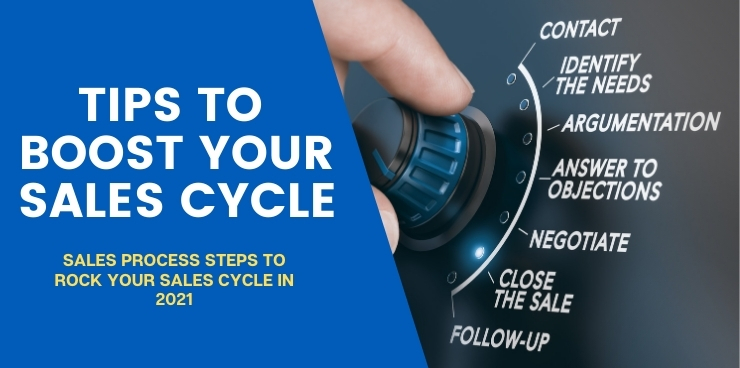Sales Process Steps to Rock Your Sales Cycle in 2021
For something that’s so fundamental to a company’s success, many business leaders have a hard time defining their sales cycle. Some refer to the end goal when discussing the sales cycle while others describe a loose philosophy around sales. The reality many sales managers miss is that a tighter, consistent structure allows for higher volume and better results.
The sales process is a series of steps that guide customers to purchase. It includes every stage, from how you generate leads all the way to closing sales.
Every sales process is unique and is ideally optimized for the customer you serve and the service you provide. While some may begin and end in a single day, B2B processes can cover days, weeks or even months. In either case, having a structure for the sales team to follow is beneficial for a number of reasons:
- Easier onboarding and training: A structure allows you to teach the process to new salespeople and outline long and short-term goals clearly.
- Process improvement: Knowing the stages of the cycle helps you find opportunities where a salesperson has trouble progressing. If they have numerous qualified leads but struggle with getting responses, focus your training on prospecting emails.
- Better measurement and management: With a clearer understanding of the stages, identifying challenges is easier. You’ll be able to employ and prioritize metrics to find coaching opportunities and optimize the process. Accountability becomes more consistent and more constructive.
From assessing potential leads to executing presentations to fostering ongoing relationships, a sound process builds efficiency at every stage.
The Seven Stages of the Sales Cycle and Effective Steps You Should Undertake to Successfully Close a Deal
In any business, the approach will be unique. For starters, the seven essential sales cycle stages create a viable framework for every sales team to follow:
- Prospecting.
- Make contact.
- Qualifying a prospect.
- Nurturing a prospect.
- Present your offer.
- Overcoming objections.
- Closing the deal.
Prospecting
The first stage of the sales process is prospecting. This is where you find potential buyers, research their needs and position and devise engagement strategies. While not as thrilling as closing the sale, effective prospecting directly leads to better close rates.
Taking time to thoroughly vet your prospect is critical. Without adequate research, you could end up trying to force poor prospects through the sales cycle. Incomplete research wastes valuable time that would have been better spent on more willing prospects.
A research model has been developed to help you identify those better leads. It’s broken down into three stages:
Step 1: Utilizing an ICP
An Ideal Customer Profile (ICP) is defining attributes of an ideal company—one that offers value and receives value from you. Unlike target customers, the ICP represents the most valuable sales prospect. With a well-established ICP, your sales process is more focused, allowing you to develop better insights into your sales effectiveness.
An ICP is developed with in-depth qualitative and quantitative research. With help from stakeholders and cross-departmental collaboration, develop a set of firmographic and behavioral attributes of your ICP.
Step 2: Targeting Potential Leads
With ICP in hand, you can start putting together a list of sales leads that match. Ideal companies can be found from online databases or even social media, such as LinkedIn. With a list of requirements, you can more efficiently filter quality leads and improve your sales prospecting.
Step 3: Pre-Contact Qualification
When you have your ICP-driven leads, you need to qualify them to put the best prospects into your sales pipeline. There are numerous qualification frameworks to choose from, but the most basic follows BANT: budget, authority, need and timing of need. When your lead meets the criteria of your solution, you’re able to execute more refined qualifying. Even in your initial contact, you should continue qualifying to determine the fit.
Make Contact
When you have qualified your lead, take the time to strategize your initial contact. It is important to plan your first impression because it will set the tone for the rest of the relationship. Even with an ideal customer, a poor prospecting call is enough to lose their business immediately.
Step 1: Identifying the Best Method
Your research should reveal practical modes of contact. You may have noticed they are active on LinkedIn and can be contacted there. Maybe you found that they operate more traditionally and would appreciate a professional email.
If you are uncertain about how to reach your lead, email is generally more effective than phone calls. Unknown numbers often go straight to voicemail, and leads will delete the message when they sniff a sales pitch. Emails, however, can get a succinct, engaging message across to spur action.
No matter which forms you prefer, a combination of methods will often be required to get the response you desire. If you establish contact via social media, support your communication with follow-up emails. Doing so increases your chances of being heard and, subsequently, the possibility of your lead responding.
Step 2: Execution
Getting your first message right is critical to moving your lead through the sales funnel. With your goal in mind, craft a concise message free of filler. Introduce yourself, establish a connection and communicate the value of your partnership. Do not go for the throat and overzealously attempt to close the deal. Desperation never yields results and you gain credibility with a more patient approach. Focus on starting a revealing conversation.
Qualify Your Prospect
When the conversation starts, it’s time to learn more about your prospect. At this stage, it’s crucial to make sure you are speaking with the decision-maker. You can leverage lower-level contacts to be your ambassador on the inside and offer initial insights. However, any significant information needs to come from the person who can pull the trigger on a purchase.
What are their goals, challenges and needs? Additionally, what is their budget and urgency in finding a solution? When you know the answer, align their situation with your value.
Honesty is key in these conversations because not all prospects will be a good fit. Being honest with yourself and your prospect will save both of you valuable time and energy. Customers appreciate humility. They acknowledge your consideration when you don’t try to cram a square peg into a round hole. When done properly, you may even be able to return to them as a prospect for a separate problem.
 Nurture Your Prospect
Nurture Your Prospect
Now that you know your prospect’s need and ability to buy, it’s time to discuss your fit. This is where you educate your prospect on your product and how it is relevant to them. While doing so, you also need to position yourself as a valuable resource for them. By projecting confidence, consistency and honesty, your prospect will offer up more useful information and be more receptive.
Even with low resistance from the prospect, you should still drive an exploratory dialogue. With the right questions, you can unearth new challenges they didn’t realize or explain added benefits of your solution.
This stage establishes urgency—a critical factor that determines your future outreach strategy. If they have a desperate need, proceed straight to the presentation. If they are not ready yet, keep them as a regular follow-up contact. When they are ready to buy, you will be a top contender for their business.
Offer Your Solution
Once the customer is fully qualified and you know they are capable and willing to buy, you make the offer. The best sales pitch examples use strong stories and compelling visuals, connecting the prospect’s challenges and goals with your solution. Using your accumulated knowledge of their position, continually reference your qualifying discussion to make your value relevant.
Overcome Objections
After your presentation, it’s time for the prospect to ask questions, provide feedback and make decisions. The best products will only solve most—not all—of a customer’s concerns. Be ready for objections about pricing, value, fulfillment, quality or terms of the deal.
When you develop a consistent sales process, you create and recognize patterns over time. With objections, you may see the same issues arise regularly. You can integrate them into your presentation before they are voiced. Using social proof in these cases helps to reinforce your defenses against difficult objections.
Obviously, not all objections can be foreseen. Patience, understanding and empathy are essential in addressing objections. Acknowledge and validate the concern, reinforcing their argument to show you are fully aware of their feelings. Then, pivot back to how your value proposition will alleviate those issues.
If the dialogue is open, ask if you have successfully handled the concern. Unfortunately, customers sometimes continue with smokescreens ending in “I’ll think about it.” This generally means you were unable to overcome your service’s deficiencies, competitors’ offers or the status quo. At this point, you should continue asking questions and stay laser-focused on the details of their responses. Try asking them if they would buy in certain scenarios to approach the objection from a different angle.
 Close the Sale
Close the Sale
Finally, ready the close when the objections are all handled. The close involves two steps:
Step 1: Sealing the Deal
You prospected accurately, qualified and built a connection culminating in an effective sales pitch that left no stone unturned. It’s decision time, and the prospect may need a gentle nudge to actually say “yes.”
This is the awkward pause, where it is best for you to elicit some response. You may briefly reinforce the value they can expect, but it ultimately comes down to asking for the sale. “We’ve discussed your concerns and agree that this solution is ideal. Would you like to finalize the deal?” This opens the door for them to either say “yes” or voice any additional objections.
Do not feel like you have to jump to discounting before asking for the sale. This is a tactic that nervous salespeople employ to get the customer to make the decision on their own. Instead, reiterate the urgency in making the decision or offer a separate incentive. Control the direction of the discussion without sounding desperate and disingenuous.
Step 2: Follow-Up
If you have covered all of these steps, be proud of your effort. No sales rep has sales techniques to close every deal. When a customer is willing yet truly incapable of buying just yet, add them back into your CRM for follow-up. Regularly keeping in contact with the prospect through questions or deals, which shows you care about and respect their business.
Best Practices for Creating Your Sales Process
Meeting your sales goals is fundamentally based on understanding the customer. Sales process steps should each be driven by a customer mindset. What are their challenges and how are they keeping them from their goals? What is their perspective on the various solutions available and what does a product or service need to accomplish for them to buy?
Think about the attitude and understanding needed to make someone want your service. Think about the process they would follow to arrive at your product. When you know their current problem and their mindset (process) in resolving it, you’re able to map a coinciding strategy.
The real key to developing efficiency in the sales cycle is an iterative process of measuring and improving. Assess your starting point and start implementing change. Measure your response and conversion rates to find and repair leaks or impasses in your sales cycle.
If you find that you convert well but have a low number of leads, find a way to fix your lead generation process. If you have a ton of business but low customer loyalty, you can tweak your follow-up strategies. Constantly measuring performance allows you to adapt your training and sales tools to mitigate weaknesses.
The Selling Revolution was designed for sales process improvement. Our consultants dive into your sales cycle to find inefficiencies and opportunities to benefit your sales team. Our goal is to build your revenue, reduce waste and establish sustainable growth strategies. If you are ready to optimize your sales cycle, start the conversation today.



 Nurture Your Prospect
Nurture Your Prospect Close the Sale
Close the Sale